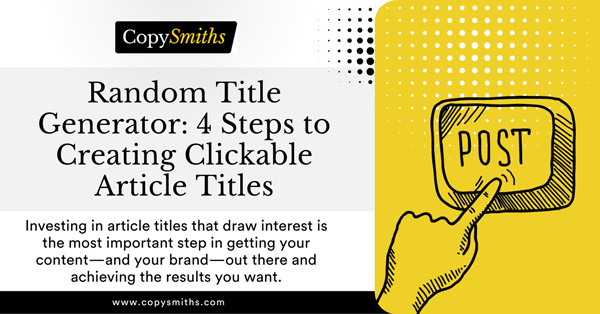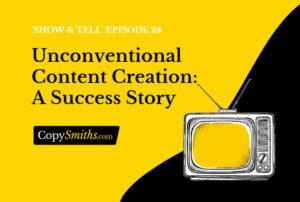Home » Content Marketing » Random Title Generator: 4 Steps to Creating Clickable Article Titles

Random Title Generator: 4 Steps to Creating Clickable Article Titles
Stop for a moment and think about why you’re reading this. Was it the headline that caught your attention? Among the billions of search results, this one somehow reached out and grabbed your attention.
As it turns out, there’s a secret to creating highly visible and clickable titles. Random title generators are the worst-kept secret when it comes to creating titles that work for search engines and human readers.
One of the most popular and effective title structures used today contains the following parts:
- A number
- Adjectives/power words
- The main keyword
- Personal words (you, your)
- Modifiers
But this simple formula fails to capture the real secret in clickable titles: emotion, urgency, and clarity.
David Ogilvy, the famous advertising guru, once said:
“On the average, five times as many people read the headline as read the body copy. When you have written your headline, you have spent eighty cents out of your dollar.”
Investing in article titles that draw interest is the most important step in getting your content—and your brand—out there and seeing the results you want.
Random article title generators can suggest compelling titles quickly and easily to help you create content at scale. But, if you want to be exceptional, you must understand the invisible factors that go into crafting compelling titles. Let’s explore what makes a title clickable.
1: Use Numbers to Provide Predictability
Which headline would you click: “The Best Way to Make Coffee,” or “Your Five Step Guide to Making Delicious Coffee”?
If you’re like me, the second title appeals to you because it provides a measurable and definite amount of information. Numbers in titles make it easy for readers to consume information.
BuzzSumo analyzed over 100 million titles to find out what makes headlines effective. They discovered that the most engaging titles contain the number 10, but other odd and even numbers also work.
We’ve learned that:
- Single digit numbers work best in article titles.
- Both odd and even numbers appear almost evenly in the most viral titles.
- The second-most popular way to start a title is with a number.
- According to SEMRush, listicles get 80% more traffic.
- In a study on its most popular articles, Medium found that 41% were listicles.
These stats emphasize the immense power numbers can have when used in article titles.
Take a look at the blog article title below on Metropolis Coffee. The headline promises choice and variety, making it an attractive choice for potential customers.
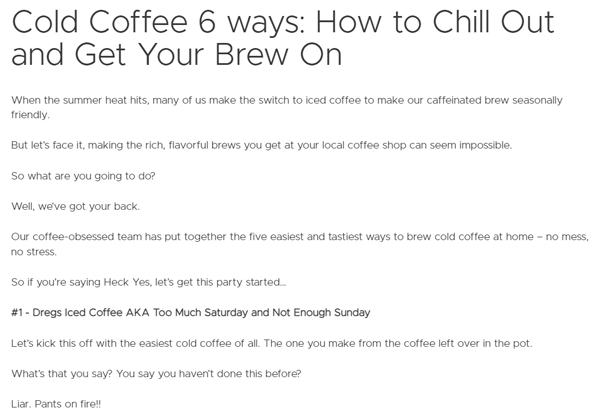
Source: Metropoliscoffee
This title is specific and concrete, and this is what allows it to grab a reader’s attention so powerfully.
Our brains also like numbers because they’re logical. Numbers help organize information into bite-sized chunks that are easy to consume. That makes listicles particularly good for scannability.
Lastly, numbers give us a sense of control. Readers are often too busy to commit five or ten minutes to read an entire blog article. Numbers in a title give a sense of brevity and simplicity, making it easier for the reader to digest the information in the article.
Let’s compare random article title ideas and their improved listicle versions as generated by our CopyCount title generator.
| Generic Title | Keyword | Suggested Titles |
| Side hustles in 2023 | Side hustle |
|
| Top corporate gift ideas | Gift ideas |
|
| Moving to a new city guide | Move, new city |
|
Immediately, you can see how the suggested titles would appeal to a reader’s mind. They’re noticeable and loud, which is one way you can get your content to stand out from everyone else’s.
That’s how you drive more traffic to your site for a chance to convert readers into buyers.
2: Show a Clear Benefit for the Reader
We all love things that benefit us in some way. You can always count on people to read your articles if the title suggests they stand to gain something.
In email marketing, one of the most powerful ways to maximize open rates is to promise something valuable in return. Similarly, an effective article title gives site visitors a reason to read your content by answering the question, “What’s in it for me?”
Benefits-driven article titles make it clear what your readers will gain if they read through to the end of the article. For instance, readers love life hacks and tips that make their lives easier and more enjoyable.
Pamela Wilson, the author of Master Content Marketing and Master Content Strategy, shares some invaluable tips and tricks on how to master headlines in the video below. She discusses how the best blog headlines make a promise and induce curiosity.
To make promises that your readers can’t resist, you must first understand your audience and their problems and needs. The best headlines don’t appeal to everyone; instead, they’re tailored to a highly specific target audience.
In Wilson’s words, a writer must always keep the ideal customer in mind.
The best writers can put themselves in the shoes of their audience and feel their pain points or challenges. Doing so helps you tailor solutions and content that appeal directly to your audience and use headlines that make readers want to hear more.
If you’re not sure what your target customers really want, conduct market research by talking with them and analyzing market data. Then, use that information to create an ideal customer persona.
3: Use Magic Words That Stimulate the Reader
There’s something all writers can learn from clickbait headlines. You’ve probably been tricked into watching a video or reading an article you regretted, but the headline was so good that you couldn’t resist it. You can use the same triggers to draw readers in.
Writers for sites like BuzzFeed have mastered the art of sensationalizing headlines in order to trigger curiosity and emotion. The secret to these headlines is word choice and phrasing.
You may already know about the most popular click magnets like free, easy, guaranteed, instant, secret, proven, discover, and now. However, you don’t have to keep repeating these overused words.
Common words can also be used to create phrases and headlines that grab the attention of users who are just “zombie scrolling”. The right words will snap them back to attention and entice them to read your article.
This list of magic words is endless because it depends on context and phrasing. Here are some of the triggers to aim for in your headline, with examples.
Surprise
The brain loves unpredictability and novelty. Surprise stimulates the brain and immediately draws the reader’s conscious attention. Pairing surprise with suspense is a winning formula because together they exploit the psychology of curiosity and information gaps.
In other words, a headline that triggers surprise prompts the reader to click on it because they experience a sense of deprivation. Naturally, they take action (clicking the title) to relieve that negative emotion with knowledge.
You can take advantage of new knowledge, like the results of case studies, puzzles, or forgotten information, to trigger this reaction.
Here’s an example of a surprising blog title. The website sells herbal supplements, so it makes sense that they would want users to know what they’re missing.

Source: Ke.iherb
Note how the headline makes you want to learn more or risk missing out on vital information.
Like surprise, curiosity is one of the fundamental human emotions that trigger the brain’s reward centers. It’s one of our most powerful human instincts, which makes it a vital ally in generating clicks.
The curiosity gap makes people care about reading your article because it creates an information void. With the right words, you can make your audience question their knowledge on a topic, allowing you to swoop in and fill that void later in the article.
Here’s a fantastic example of a blog title featured on a winery website that inspires curiosity.
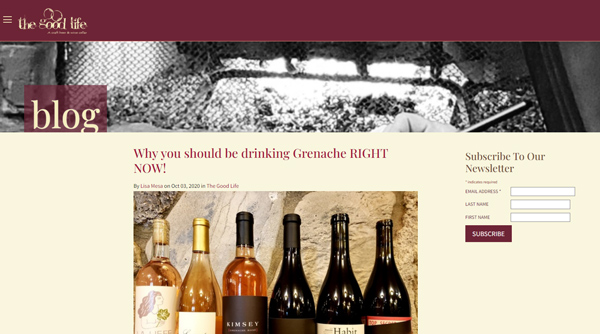
Source: Thegoodlifecellar
Like an itch you want to scratch, this headline makes you want to learn about why and how you should drink Grenache. You can trigger curiosity in the same way by challenging common knowledge or revealing new information.
Negativity
Negative phrases can be a powerful trigger when used appropriately. While people are tired of positive superlatives like best and greatest, negative words are a fresh and sometimes more effective option.
Negative words and phrases cause the reader to want to avoid a bad outcome by triggering their pain points. Here’s an example from Mighty Fit using the word never.
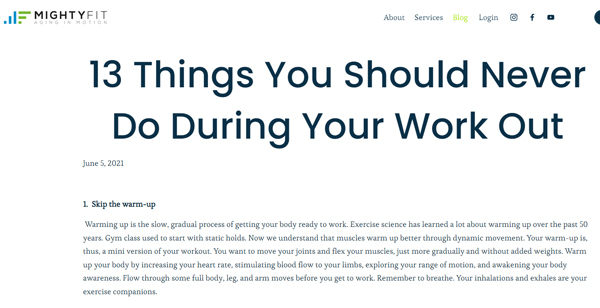
Source: Mighty.fit
This article title triggers a sense of urgency and persuades the reader to click in order to learn what they need to do to avoid a negative outcome.
Another popular form of negative titles takes this format: “Want to Grow Your Business? Stop Paying For These Nonessentials.”
Expert Tip: You can also grab the reader’s attention with outrageous blog titles. Here are a few examples to stimulate your creativity.
- SEO Is Dead. Link Building Is Dead. Your Pony Is Dead — Ana Hoffman
- Why Breakfast Is Not the Most Important Meal of the Day — Dick Talens on Lifehacker
- How to See Straighter by Crossing Your Eyes — David Cain on Raptitude
Get the idea? The right amount of outrageousness or controversy can help your best content go viral.
Specificity
Precision and clarity are vital in article titles. However, there are ways you can phrase them to be so exact and specific that readers can’t help but think, “No way!”
Such a title is persuasive and tempts readers to open the article and see what’s going on.
Jon Morrow, the founder of ProBlogger, once wrote an oddly specific title: How to Quit Your Job, Move to Paradise and Get Paid to Change the World.
This is such a powerful title; it makes you think that the writer must know what they’re talking about and even suggests that there’s a secret to learn.
Here’s another example of a refreshingly specific blog title on Helm Boots, a successful business that designs, produces, and sells footwear.
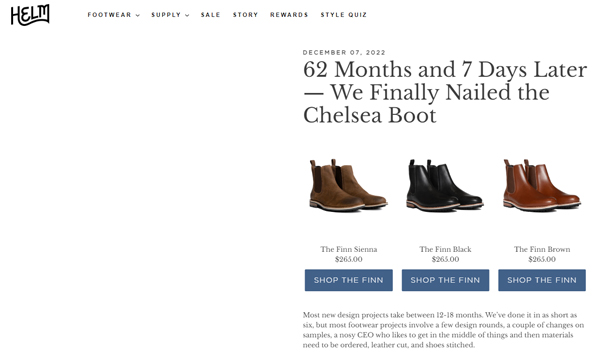
Source: Helmboots
This is a curious title because it’s so specific that you can’t help but click. Precise and detailed information like this inspires authenticity and trust that helps readers overcome any initial hesitation.
You can do the same using article titles that contain concrete facts, hard statistics, and precise language. You’ll find that such titles tend to be longer than usual, but that’s okay. Just focus on making them exceptional and intriguing.
Expert Tip: Be careful with overly sensational and emotional titles. People today are on guard against anything that sounds exaggerated or overly hyped. Many magic words, such as superlatives (best and greatest) have also become cliched through overuse.
4: Test Multiple Titles and Measure Results
You can spend hours crafting the perfect headline, but the work doesn’t stop there. Despite your best efforts, your article titles can still fail to bring in traffic.
That’s why it’s vital to experiment with multiple headlines and measure the results for each option. When you find which ones work for you, you can create a title formula that ensures repeated success, just like these highly successful eCommerce blogs.
If you’re confident that you have an article worth reading, changing up the title and comparing the response will help you determine the most effective formats. But, this requires a quick and affordable way of generating high-quality titles.
Thanks to AI and machine learning technology, random title generators have become incredibly good at creating article titles.
Let’s try the CopyCount title generator with the keyword home gardening and see what happens.
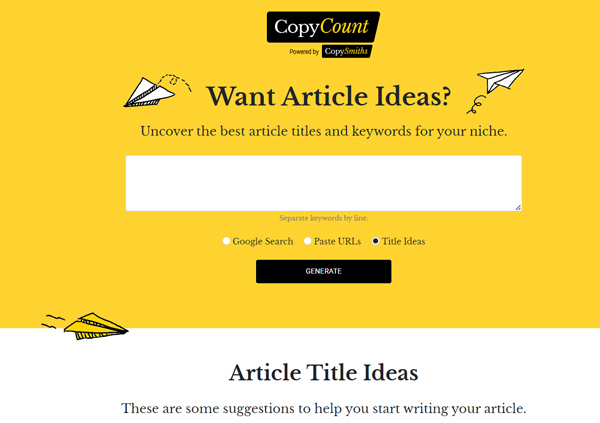
Source: CopyCount
When we click generate, the free tool instantly analyzes millions of other titles with similar keywords and provides over a hundred suggestions.

Source: CopyCount
As you can see, the title generator offers an abundance of options that incorporate the tips we’ve discussed and more. The tool can be used to instantly optimize your article titles and create multiple options to experiment with.
Better still, the CopyCount title generator can be used to generate title ideas for your website. Use it to create hundreds of new article titles based on long and short tail keywords to help you expand the content on your website.
Armed with these content ideas, you can now create in-depth content that will bring in the customers.
Are You Ready to Craft Engaging Content?
Writing compelling and clickable titles is a lot of work, isn’t it? But we’re just getting started. Creating high-quality content consistently and at scale is beyond the reach of most businesses.
At CopySmiths, it’s our duty to help business owners like you create the content you need to build a competitive online brand. Our clients love us because we focus on the kind of content that elicits responses and drives both traffic and conversions.
“I’m really impressed at the quality of content that CopySmiths produces. My niche is boring, but CopySmiths is very creative and consistently comes up with unique angles to address the topic.” — Alan Marek, PartCatalog
We write the kind of content that helps you stand out amid all the noise and competition. Subscribe to our CopyZine Newsletter to learn more about creating quality content and article headlines today.
Share on LinkedIn:
CopySmiths
I'm Katrina McKinnon, founder of CopySmiths and Small Revolution. In my 20 years of experience, I have helped online businesses create high-performing content specifically on an eCommerce store's blog. Find me on LinkedIn and Twitter.
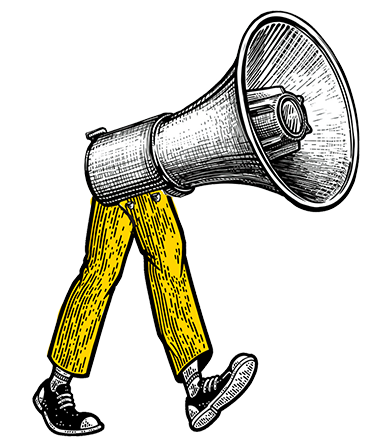
CopySmiths offers the best blog writing services for online stores.
If you'd like us to write blog articles for you, click here.
Most Recent
- 3 Bold Questions You Should Ask When Hiring A Content Writer

- 5 Practical Reasons You Should Use a Blog Post Template

- 4 Amazing Benefits of Using a Title Generator for New eCommerce Blogs

- 10 Awesome Bio Examples Your Online Store Blog Should Emulate

- 8 Basic Steps to Successful Content Development Every Time

Podcasts
Got a question?
Ask our friendly team about our article writing services.
Subscribe to CopyZine
Monthly, hand-picked stories of the best in eCommerce Content.

